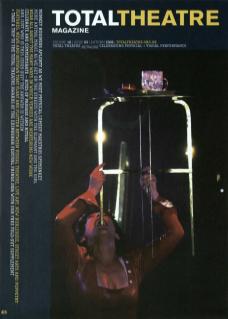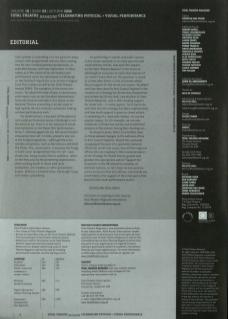Late summer is something of a low point for many venues, with programmed seasons often making way for non-curated amateur productions, or even dark houses until late September. It often seems as if the whole of the UK theatre and performance world has decamped to Edinburgh as the Festival Fringe kicks into action in August (and this is where we will be for Total Theatre Awards 2006). The exception is the street arts sector, for whom this time of year is the busiest, with events such as the Stockton International Riverside Festival and Watch This Space at the National Theatre presenting a broad range of high quality UK and overseas companies making outdoor performance work.
For street artists, a key part of the physical and visual performance sector, Edinburgh is not the place to be. There is a fair amount of street entertainment on the Royal Mile (gold statues, stripy T-shirted jugglers et al), but street theatre companies have not, to date, played a key role in the Fringe programme – although there are notable exceptions, such as Boilerhouse and Walk The Plank. This, we presume, is because the Fringe is itself a non-programmed free-for-all – and street arts, being usually free to audience, relies on the fees paid by the presenting organisation often working hand-in-hand with local authorities, arts funders or other government bodies. Without a ticketed show, Edinburgh Fringe isn't really a possibility.
As performing in streets and public spaces is the modus operandi of so many physical and visual theatre artists, how does this impact on the Total Theatre Awards? Is the focus on Edinburgh an exclusion of some vital aspects of our remit? Some think so! The question is raised at a time when there is a lot of anxiety about future support for the street arts sector. Excellent work has been done by Arts Council England in the creation of a Strategy for Street Arts (researched and written by Felicity Hall, now director of Total Theatre Network), and in their funding support for street arts – in some regions. For it has to be said that how the strategy has been implemented, and how much support is given to street artists, is something of a ‘postcode lottery', to use the popular jargon. So, for example, we see new initiatives in Bristol but worthy and established projects in Manchester having their funding cut.
As we go to press, there is no further news on the proposed changes to the national office of Arts Council England. Should the rumoured scrapping of the post of a specialist national officer for street arts occur, how will the regional offices who are slacking in their implementation of the Strategy for Street Arts be guided and goaded into appropriate action? Support for street arts in the UK should be a matter of national concern, so let's hope we see positive action to ensure that arts officers nationwide are committed to the support of this vital part of the physical and visual performance sector.

